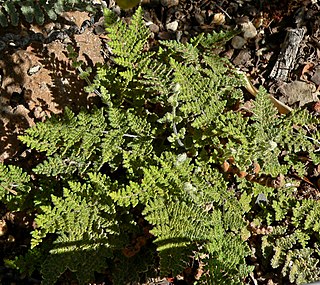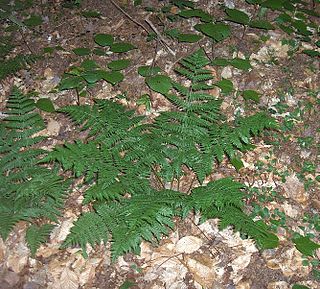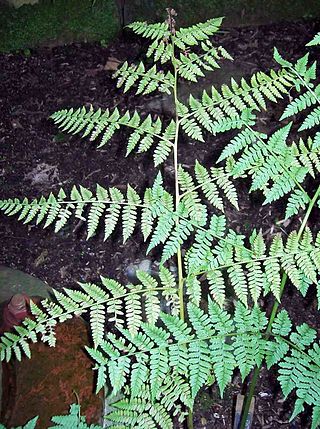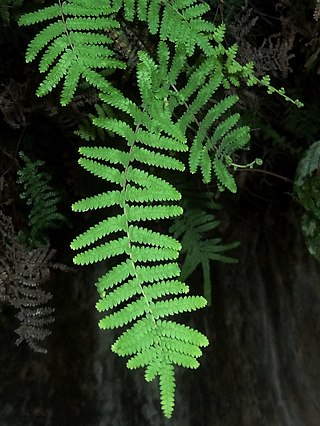
Pleopeltis polypodioides, also known as the resurrection fern, is a species of creeping, coarse-textured fern native to the Americas and Africa.

Polypodium glycyrrhiza, commonly known as licorice fern, many-footed fern, and sweet root, is a summer deciduous fern native to western North America, where it is found in shaded, damp locations.

Myriopteris gracilis, formerly known as Cheilanthes feei, is a species of lip fern known by the common name slender lip fern or Fee's lip fern.

Aspidotis densa is a species of fern in the Cheilanthoid subfamily, known by the common name Indian's dream or Serpentine fern or dense lace fern. It is native to the west coast of North America from British Columbia to California and east to the Rocky Mountains in Idaho, Montana, and Wyoming; there is a disjunct population on serpentine soils in Quebec.

Myriopteris gracillima, formerly known as Cheilanthes gracillima, is a species of lip fern known by the common name lace lip fern. It is native to western North America, where it grows in rocky habitat from British Columbia to California to Montana.

Myriopteris intertexta, formerly Cheilanthes intertexta, is a species of lip fern known by the common name coastal lip fern. It is native to montane California and western Nevada, Oregon east of the Cascades, and with a disjunct population in central Utah. It grows in dry rocky habitats in sun, typically in rock cracks with little or no soil.

Zealandia pustulata is a species of fern native to eastern Australia and New Zealand. It is commonly referred to as kangaroo fern because of its mature leaves tend to resemble the shape of a kangaroo foot. It is also referred to as hound's tongue, and as kōwaowao and pāraharaha in Māori.

Dryopteris intermedia, the intermediate wood fern or evergreen wood fern, is a perennial, evergreen wood fern native to eastern North America. It is a diploid species, and is the parent of several species of hybrid origin, including Dryopteris carthusiana. Other common names for this species include intermediate shield fern, fancy wood fern, fancy fern, glandular wood fern, American shield fern and common wood fern.

Deparia acrostichoides, commonly called silvery glade fern or silvery spleenwort, is a perennial species of fern. Its range includes much of the eastern United States and Canada, from Ontario to Nova Scotia and Georgia to Louisiana, as well as eastern Asia in China, Russia, Japan and Korea. The name silvery comes from the fact that the indusia on the underside of the leaf have a silver color when the sori are close to ripening.

Polypodium hesperium is a species of fern known by the common name western polypody. It is native to western North America from British Columbia to California, and the Rocky Mountains to northern Mexico, where it grows in rocky habitat types.

Polypodium scouleri is a species of fern known by the common names leathery polypody, Scouler's polypody, coast polypody and leather-leaf fern. It is native to coastal western North America from British Columbia to Guadalupe Island off Baja California. It is a plant of the coastline, growing in cracks on coastal bluffs, in oceanside forests, beach dunes, and similar habitat. It is often affected by heavy fogs and sea spray. This polypody anchors with a waxy, scaly rhizome. It produces triangular or oblong leaves up to 85 centimeters in maximum length and 8 cm width. Each leaf is made up of many round-tipped linear or oblong segments which are usually stiff and leathery in texture and edged with shallow, rounded teeth. The underside of each leaf segment is crowded with rounded sori each up to half a centimeter wide. The sori contain the spores.

Polystichum lemmonii is a species of fern known by the common names Lemmon's holly fern and Shasta fern. It is native to western North America from the Sierra Nevada of California north to Washington. It is also known from British Columbia, where there is a single occurrence in the mountains above the Okanagan Valley.

Physematium scopulinum, common name Rocky Mountain woodsia, is a deciduous perennial fern in the family Woodsiaceae.

Diplazium australe, commonly known as the Austral lady fern, is a small fern occurring in eastern Australia, New Zealand and Norfolk Island. The habitat is moist shaded areas, often occurring in rainforest.

Gleichenia polypodioides (L.) Sm., commonly known as coral fern, kystervaring or ystervaring due to its glabrous, brown, wiry stipes. The species is widespread in south- and east tropical Africa, southern Africa and the western Indian Ocean region. It occurs naturally in a broad coastal belt in South Africa, Lesotho, Eswatini, Angola, Malawi, Burundi, Tanzania, Mozambique, Zimbabwe, Mauritius, Réunion, Amsterdam Island and Madagascar, and was first described by Carl Linnaeus in 1771 under the name Onoclea polypodioides. Often forming dense and impenetrable thickets, sometimes over large areas, this rhizomatous perennial is an important pioneer in disturbed areas such as pine plantations. It is often mistakenly seen as an exotic invader rather than as a useful rehabilitation plant, a source of peat and growing medium, while showing exceptional resistance to herbicides.
Rhizome brown, 1–2.5 mm. in diam., creeping, with long-spined dark-brown scales up to 0.5 mm. in diam., with fronds spaced 2–20 cm. apart. Stipe castaneous, up to 60 cm. long and up to 1.5 mm. in diam., glabrous or with a few scales similar to those on the rhizome, shallowly sulcate. Frond bifurcate to reniform-lunate in outline, with 1 level of false dichotomy in each lateral branch system arising from each side of the terminal bud; all branches bearing distant foliar segments. Aborted apical buds up to 1.2 mm. long, clothed in dark-brown lanceolate laciniate scales. Pinnules linear, up to 7 x 0.75 cm., pinnate, usually glabrous, divided into sessile rounded entire triangular lobes, 3 x 2 mm., green to glaucous below. Sori partially immersed in the lamina, consisting of 2–4 sporangia, each in a separate but adjoining pit.
Myriopteris aemula, the Texas lip fern or rival lip fern, is a moderately-sized fern of Texas and Mexico, a member of the family Pteridaceae. Unlike many members of its genus, its leaves have a few hairs on upper and lower surfaces, or lack them entirely. One of the cheilanthoid ferns, it was usually classified in the genus Cheilanthes as Cheilanthes aemula until 2013, when the genus Myriopteris was again recognized as separate from Cheilanthes. It typically grows on limestone rock.
Argyrochosma connectens is a small cheilanthoid fern endemic to Sichuan, China. It is the only member of its genus known from Asia. Relatively rare, it is found growing in the crevices of limestone rocks in hot, dry valleys. The species was long classified in the genus Pellaea, but after a phylogenetic study in 2015 was transferred to Argyrochosma.

Gymnocarpium disjunctum is a species of fern in the family Cystopteridaceae, commonly known as Pacific oak fern, western oak fern, or Pacific oakfern.

Myriopteris scabra, commonly known as rough lipfern, is a species of cheilanthoid fern native to Mexico and the south-western United States (Texas).
Myriopteris lendigera is a species of cheilanthoid fern with the common name nit-bearing lip fern.

















